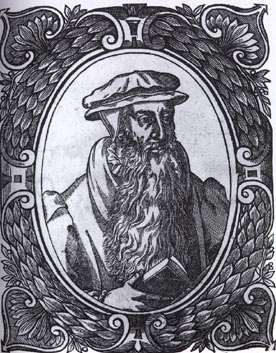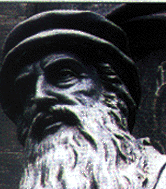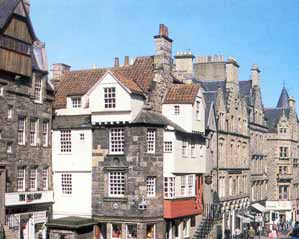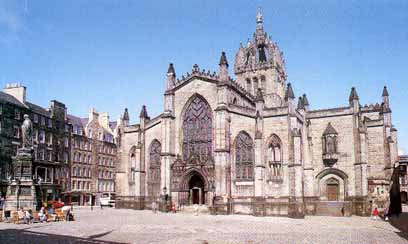
John Knox was born in a street named "Giffordgate" in the
Scottish town of Haddington in East Lothian, some time in 1514. His father,
William Knox, was a merchant or craftsman, but little is known about his mother,
who was probably one of the Sinclairs of Northrig. He had a brother, William,
who later became a successful merchant too. Knox's parents died in unknown
circumstances when the boys were still young, and they were taken in by a
wealthy family who enabled Knox to leave home at the age of 15 and go and study
in St Andrews in Fife. Although Knox had already been exposed to the growing
wave of Protestantism, he became a priest when he left university, as had been
decided for him. However, the seed of Knox's conversion had already been sown,
and he was further impressed by the travelling preacher, George Wishart whom he
befriended. In 1546, when Wishart was tried for heresy and burnt at the stake by
Cardinal David Beaton, Knox went into hiding. Cardinal Beaton was murdered and
the Castle of St Andrews besieged by the murderers, and Knox was encouraged to
take on the role of preacher too. His fluency, sarcasm and directness earned him
popularity, and he set about denouncing the corruption of the Roman Catholic
Church, using the Scriptures as his source. By July 1547, the French fleet
summoned by the Scottish Queen Regent, Mary of Guise (Mary, Queen of Scots'
mother) came to the rescue and retook possession of St Andrews Castle. Beaton's
murderers were captured and sent away as galley slaves, including John
Knox. Knox used his time in the French galleys to strengthen his new faith
until his eventual release. Back in London, the Privy Council saw in him an
opportunity to spread Protestantism and sent him to preach in
Berwick-upon-Tweed. There, in the parish church of St Mary, he attracted crowds
of recent converts, curious Catholics and Scots, who crossed the border
illegally to listen to him.
One of the issues dear to Knox concerned the doctrine of transubstantiation.
According to Catholics, the bread and wine consecrated during the Mass
physically changed into the body and blood of Christ. The reformers did not
agree with that, nor with the use of incense, bells, solemn music and colourful
vestments during Mass. Latin should be done away with and the word Mass itself
should be replaced by Communion or Lord's Supper. Whether people should kneel or
sit while receiving the bread and wine later proved to be an irreconcilable bone
of contention between Knox and other fellow Protestants.
Knox's popularity took him to Newcastle in 1551 and to the court of Edward VI
after the death of the Duke of Somerset. Refusing the bishopric of Rochester,
Knox returned to Newcastle where his sermons became increasingly politicised. He
made himself a few powerful enemies by accusing statesmen of undermining the
Protestant Church.
Knox's misogyny is legendary. Behind this blatant hatred
however, lay a more complex persona. His relationship with Elizabeth Bowes has
long raised some eyebrows. About ten years older than Knox, Elizabeth was
married to Richard Bowes, Captain of Norham Castle, when she was only 16 and
bore him numerous children. Although a devout Catholic, she became increasingly
troubled and converted to the new faith. She was first introduced to Knox when
she went to listen to him in Berwick in 1549. Elizabeth had particular
difficulty with the Protestant doctrine of predestination, and sent Knox long
and mournful letters requesting his advice. The relationship probably remained
that of preacher and parishioner, although the tone of Knox's letters throws a
definite doubt on that. Whatever the case, it seems that Richard Bowes was not
overly perturbed by his wife's friendship with Knox. Elizabeth may have played
more the role of mother than mistress to Knox, and she decided that he should
find himself a wife. Her choice was her own fifth daughter, Marjorie, an
educated girl of 16 or 17. There is no doubt that Knox, an impoverished man of
35, saw this as a golden opportunity, which is probably why her father was
reluctant to give his consent. Knox and Marjorie were betrothed but Richard
Bowes refused to complete the marriage contract and hand over the dowry. By that
time, King Edward was seriously ill and the prospect of his half-sister, the
Catholic Mary Tudor, succeeding him must have made Richard Bowes even more
unwilling to have a renegade priest for son-in-law. Knox commuted between the
southern counties and Berwick, keeping an active correspondence with Elizabeth.
On the accession of Mary Tudor, Knox thought it prudent to flee to the safety of
France, not without guilt for having forsaken his congregation. The politically
tainted sermons now began to take the shape of open incitation to rebellion in
Knox's mind. Still unsure of himself, he travelled to Geneva to consult the
leading Protestant authority, John Calvin.
Although Calvin echoed Knox's opinion of women, believing that a female monarch
was a punishment from God for the sins of mankind, he fell short of recommending
disobedience. Disappointed, Knox continued his tour of the Swiss theologians
until he had gathered enough justification for his new line of attack. Back in
the French town of Dieppe, he started publishing various anonymous tracts
advocating resistance to Mary I, which were smuggled across into England. In
late July 1554, Knox returned to Geneva with the intention of studying, but was
quickly prompted by Calvin to go to Frankfurt in Germany, where a group of
English Protestant exiles had chosen him to be their pastor. He took his duties
in the autumn of 1554 at the Church of the White Ladies but only to find himself
embroiled in academic disputes over which form the service should take. A huge
rift developed between the Protestants who supported the Common Book of Prayer
and those who did not. Eventually, Knox gave up and returned to the peace of
Geneva, but only a few months later he was called back to Scotland by the
Scottish Protestants who needed a leader to secure the Reformation. Knox was not
keen to go but Elizabeth Bowes managed to change his mind and he arrived in
Edinburgh in September 1555. His arrival provoked a great deal of interest, and
he divided his time between preaching and meeting up with influential public
figures throughout Scotland. Besides attacking the Catholic practice of fasting
during Lent, he also proclaimed that tithes should no longer be paid to the
Church, as the proceeds were not spent on the poor. Mary of Guise, fearing a
riot, sheltered Knox from prosecution. Knox saw this as an opportunity to show
the Queen Regent the error of her Catholic ways, and he sent her a letter to
this effect. Mary of Guise was not impressed by this agitator who dared lecture
her as well and said to James Beaton, Archbishop of Glasgow: "Please you,
my Lord, to read a pasquil (satire)". Knox never forgave her for that
remark.
Soon, Knox was once more called to Geneva to be the leader
of the congregation of exiles there. He readily accepted, sending Elizabeth and
Marjorie (whom he had recently married in Edinburgh) ahead. He joined them
in Dieppe accompanied by a servant and a student, and reached Geneva in
September 1556. He was reunited with some of his colleagues from Frankfurt and
could once more resume his preaching at leisure. Elizabeth became his
housekeeper and Marjorie his secretary. Their first son, Nathaniel, was born.
Another friend of Knox's then arrived from London, Anna Locke. Anna was some
fifteen years younger than Knox, and like Elizabeth, thirsted for Knox's
spiritual guidance in the form of long and frequent letters. Again, the language
and tone of the letters raise suspicions, but Anna's husband was quite happy to
let her travel to the safer Geneva. Knox continued to keep in contact with her
from wherever he was throughout the years.
 In May 1557, Knox was once more dragged away from his
congregation by the Protestant nobility, but only to find that he had made a
wasted journey to Dieppe. Furious, he stayed on for a while, expressing his
concerns about the ambiguous attitude of the Lords who, motivated by
self-interest, had accepted the marriage of the young Mary Stuart to the French
Dauphin, François, and the influence of the Duke of Châtelherault. Back in
Geneva three months later, he began writing his most popular works "History
of the Scottish Reformation" and the infamous "First Blast of the
Trumpet against the Monstrous Regiment of Women". In the latter, he
attempts to demonstrate the inferiority of women and rambles on about his
favourite subject of women and the state, openly attacking the rule of Mary I of
England. Knox conveniently avoided mentioning this work to Calvin, in the
knowledge that he would never approve such revolutionary ideas. Mary Tudor's
response to the First Blast was to ban imports of seditious and heretical books
into England, while Protestants at home and abroad were shocked at the tone Knox
was taking. Calvin dissociated himself completely from it and banned its sale in
Geneva. Knox also found it necessary to publish various other tracts against
Mary of Guise, relishing the loss of her husband and two baby sons, which he
proclaimed, was God's punishment for her sins. Knox had become an extremist,
inciting people to violence against their ruler.
In May 1557, Knox was once more dragged away from his
congregation by the Protestant nobility, but only to find that he had made a
wasted journey to Dieppe. Furious, he stayed on for a while, expressing his
concerns about the ambiguous attitude of the Lords who, motivated by
self-interest, had accepted the marriage of the young Mary Stuart to the French
Dauphin, François, and the influence of the Duke of Châtelherault. Back in
Geneva three months later, he began writing his most popular works "History
of the Scottish Reformation" and the infamous "First Blast of the
Trumpet against the Monstrous Regiment of Women". In the latter, he
attempts to demonstrate the inferiority of women and rambles on about his
favourite subject of women and the state, openly attacking the rule of Mary I of
England. Knox conveniently avoided mentioning this work to Calvin, in the
knowledge that he would never approve such revolutionary ideas. Mary Tudor's
response to the First Blast was to ban imports of seditious and heretical books
into England, while Protestants at home and abroad were shocked at the tone Knox
was taking. Calvin dissociated himself completely from it and banned its sale in
Geneva. Knox also found it necessary to publish various other tracts against
Mary of Guise, relishing the loss of her husband and two baby sons, which he
proclaimed, was God's punishment for her sins. Knox had become an extremist,
inciting people to violence against their ruler.
When Elizabeth I succeeded Mary in 1558, she was also infuriated by Knox's
insubordination and views against female rulers as a whole. She refused to grant
Knox a safe conduct through her realm when he was recalled to Scotland at the
end of the year. Knox complained in vain and had to undertake the journey by sea
instead, landing at Leith in May 1559. Marjorie, who had given birth to their
second son Eleazer, stayed behind in Switzerland. Knox found Scotland in a state
of turmoil. Mary of Guise no longer believed that the Protestants' demands were
motivated by genuine religious reasons but rather by a political agenda. She intended
to have the dissident preachers outlawed and banished at Stirling, but Knox and
the Lords marched on Perth. There, on 11 May 1559 from the pulpit of St John's
Kirk, Knox preached a violent sermon against idolatry, which later led to the
widespread destruction of the contents of the same church and local friaries.
Knox was jubilant but later dissociated himself from the damage caused by
attributing it to the "rascal multitude". Mary of Guise was forced
into peace negotiations with the Scottish nobility but Knox still continued to
vociferate against her and incite the mob to violence. So much so that Mary of
Guise was compelled to seek French help while the Lords opened up negotiations
with England, replacing the tactless Knox with Maitland of Lethington as their
emissary. Elizabeth remained wary and unwilling to be seen to be supporting
rebels against their ruler but eventually, English forces arrived in Scotland
and the siege of Leith followed. Reunited with Elizabeth Bowes and Marjorie,
Knox continued to spit his venom from St Andrews. Mary of Guise had retired to
the safety of Edinburgh Castle and was seriously ill with dropsy. This did not
stop Knox who, alleging that she had gloated at the sight of English corpses
hung on the walls of Leith from the windows of Edinburgh Castle (which anyone
who has ever been to Edinburgh will know is impossible), said: "within a
few days thereafter, began her belly and loathsome legs to swell, and so
continued till God did execute his judgment upon her." On 7 June 1560 Mary
of Guise succumbed to her illness and the Treaty of Edinburgh was signed. By 10
July 1560, Parliament passed a series of Acts which would make Scotland an
officially Protestant country. The First Book of Discipline, on which Knox and
other ministers had been working since the previous spring, contained detailed
proposals concerning the policy and discipline of the Church of Scotland. These
wide-ranging proposals were passed on 27 January 1561, but it would be a long
time before these were fully implemented. Knox turned down the post of
superintendent and was given comfortable lodgings in Trunk Close off the High
Street, together with the highest salary payable to a minister.
In November 1560 Marjorie died, leaving Knox depressed and
struggling to cope with his two sons. Mary of Guise might be dead and Scotland a
reformed country but the French danger was still present in his mind. The French
Dauphin had refused to ratify the Treaty of Edinburgh and there were rumours
that the French were planning to send more forces to Scotland. Knox was relieved
when he heard of the Dauphin's death in December 1560, but saw the return of the
Catholic Mary, Queen of Scots with great foreboding. He was deeply suspicious of
her from the very beginning and always refused to treat her as a fellow human
being. His negative attitude towards her would grow into a most obsessive and
unchristian hatred. Mary, who had just lost both her mother and
husband at short interval, had no sympathy for this evil man who had made her
mother's life hell, and put his despicable views to paper in the First Blast.
She wanted him banished from Scotland, and her half-brother Lord James, knew
that there was no way she would set foot in Scotland unless he obtained some
sort of written apology from Knox. Knox, who did not know the meaning of
humility and forgiveness, refused to apologise but pretended that the First
Blast had been written with Mary I in mind and no one else. This of course did
not prevent him from saying about Mary when she first returned: "The
very face of heaven the time of her arrival did manifestly speak what comfort
was brought unto this country with her, to wit, sorrow, dolour, darkness
and all impiety." Although Mary always showed great tolerance
towards the new religion and went out of her way to compromise with the
Protestants, Knox was incapable of showing this level of understanding and
conciliation. Within days of her return, he was denouncing the Mass which she
was attending in private in the Chapel of Holyroodhouse, and spewed his hatred
from the pulpit of St Giles at every opportunity. Nothing which Mary said or did
obtained his approval, but few of the Lords agreed with his outright
condemnation. Mary subjected herself to
five interviews with Knox, without
positive outcome.
For all his hatred of women, Knox found it impossible to
cope on his own and, on 25 March 1564, he caused scandal by marrying Margaret
Stewart, the 16-year old daughter of his friend Lord Ochiltree, and niece of the
Duke of Châtelherault. Again, Knox had shown where his preferences lay: youth
and social standing. As for his two sons, they were sent to be educated in
England with their Bowes relatives. During the seven years of Mary's rule, Knox
managed to fall out with just about everybody, including Lord James Stuart, Earl
of Moray and half-brother of the Queen. The General Assembly even convened a
special meeting in an attempt to tone down Knox's attacks against Mary, but it
broke down in disarray with nothing achieved. He disliked Darnley and hated
Riccio, and openly approved of the murder of the latter, cautiously leaving for
Ayrshire to avoid prosecution. After the birth of Mary's son in 1566, Knox went
to England to visit his sons, and back in Scotland after Darnley's murder, lost
no time in demanding that Mary be put to death for her sins. Even after Mary's
forced abdication, Knox continued to preach against her five times a week, and
his paranoia persisted even after her flight to England. "We
look daily for the arrival of the Duke and his Frenchmen, sent to restore Satan
to his kingdom in the person of his dearest lieutenant.", he wrote.
Knox was disappointed by Elizabeth's lax handling of Mary and constantly feared
a plot to assassinate the Regent Moray or Mary's son, the little King James VI.
More than ever, he wanted Mary dead: "If ye strike
not at the roots, the branches that appear to be broken will bud again (and that
more quickly than any man can believe) with greater force than we would wish."
When Moray was eventually murdered, Knox reduced the congregation to tears by
praising his virtues at his funeral.
During all these events, Knox had been leading a content and comfortable life
with his young bride, who had given him two daughters, Martha in 1565 and
Margaret in 1567. Like Marjorie, she was an educated and devoted wife who helped
him with his paperwork and entertained his many guests. She bore him a third
daughter Elizabeth in 1570.
In the autumn of 1570, Knox suffered a stroke but
continued to demand Mary's death, rendering him unpopular with the more moderate
Protestants. A former friend of his, Kirkcaldy of Grange, had switched over to
the Queen's party, and on 30 April 1571, issued a proclamation ordering all
supporters of the King's party to leave Edinburgh within six hours. Knox refused
at first but was finally persuaded to go in May 1571, and left with his
secretary Richard Bannatyne and his family. In St Andrews, he went on ranting
and raving from the pulpit despite his old age and ill health, attracting both
admiration and dislike from the academic community. On 31 July 1572, the King
and the Queen's parties signed a truce and Knox returned to Edinburgh, where he
resumed his preaching and lecturing from St Giles Cathedral. He finally died of
pneumonia on 24 November 1572 at his home in Trunk Close. He was buried in the
former cemetery behind St Giles.
|



 In May 1557, Knox was once more dragged away from his
congregation by the Protestant nobility, but only to find that he had made a
wasted journey to Dieppe. Furious, he stayed on for a while, expressing his
concerns about the ambiguous attitude of the Lords who, motivated by
self-interest, had accepted the marriage of the young Mary Stuart to the French
Dauphin, François, and the influence of the Duke of Châtelherault. Back in
Geneva three months later, he began writing his most popular works "History
of the Scottish Reformation" and the infamous "First Blast of the
Trumpet against the Monstrous Regiment of Women". In the latter, he
attempts to demonstrate the inferiority of women and rambles on about his
favourite subject of women and the state, openly attacking the rule of Mary I of
England. Knox conveniently avoided mentioning this work to Calvin, in the
knowledge that he would never approve such revolutionary ideas. Mary Tudor's
response to the First Blast was to ban imports of seditious and heretical books
into England, while Protestants at home and abroad were shocked at the tone Knox
was taking. Calvin dissociated himself completely from it and banned its sale in
Geneva. Knox also found it necessary to publish various other tracts against
Mary of Guise, relishing the loss of her husband and two baby sons, which he
proclaimed, was God's punishment for her sins. Knox had become an extremist,
inciting people to violence against their ruler.
In May 1557, Knox was once more dragged away from his
congregation by the Protestant nobility, but only to find that he had made a
wasted journey to Dieppe. Furious, he stayed on for a while, expressing his
concerns about the ambiguous attitude of the Lords who, motivated by
self-interest, had accepted the marriage of the young Mary Stuart to the French
Dauphin, François, and the influence of the Duke of Châtelherault. Back in
Geneva three months later, he began writing his most popular works "History
of the Scottish Reformation" and the infamous "First Blast of the
Trumpet against the Monstrous Regiment of Women". In the latter, he
attempts to demonstrate the inferiority of women and rambles on about his
favourite subject of women and the state, openly attacking the rule of Mary I of
England. Knox conveniently avoided mentioning this work to Calvin, in the
knowledge that he would never approve such revolutionary ideas. Mary Tudor's
response to the First Blast was to ban imports of seditious and heretical books
into England, while Protestants at home and abroad were shocked at the tone Knox
was taking. Calvin dissociated himself completely from it and banned its sale in
Geneva. Knox also found it necessary to publish various other tracts against
Mary of Guise, relishing the loss of her husband and two baby sons, which he
proclaimed, was God's punishment for her sins. Knox had become an extremist,
inciting people to violence against their ruler.